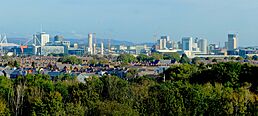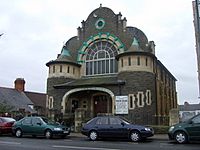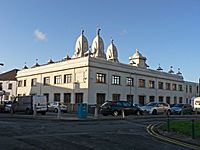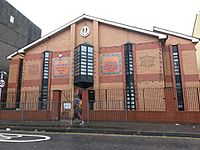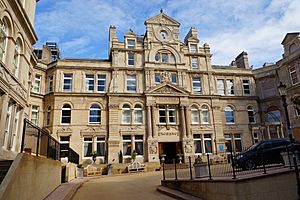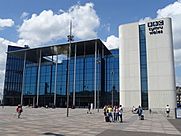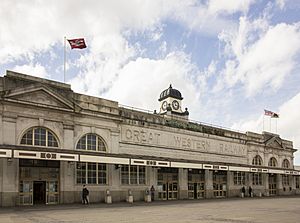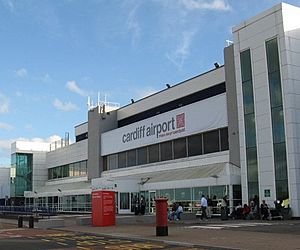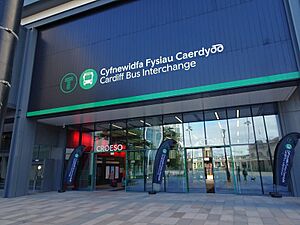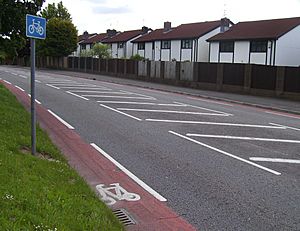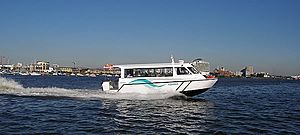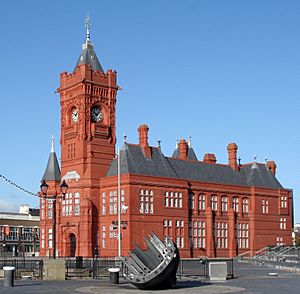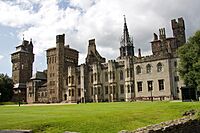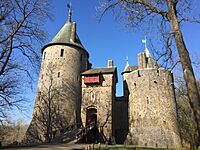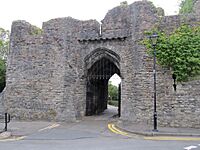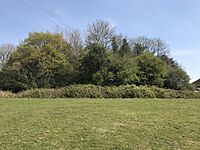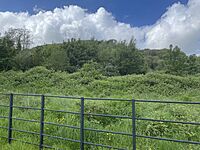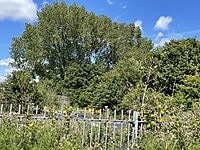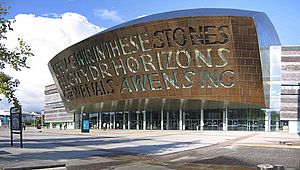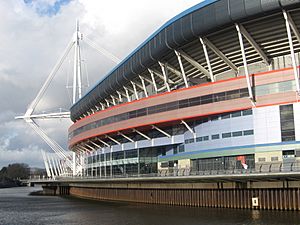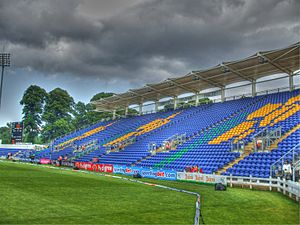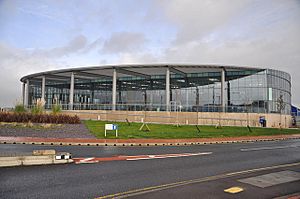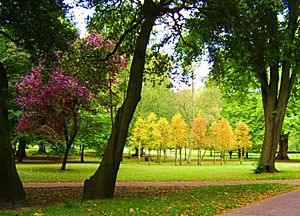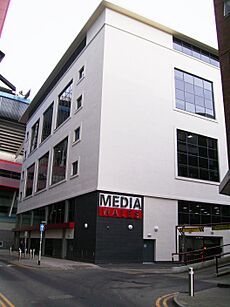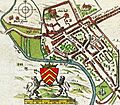Cardiff facts for kids
Quick facts for kids
Cardiff
Caerdydd (Welsh)
|
|||
|---|---|---|---|
|
Capital city and county
|
|||
|
|||
| Motto(s): | |||
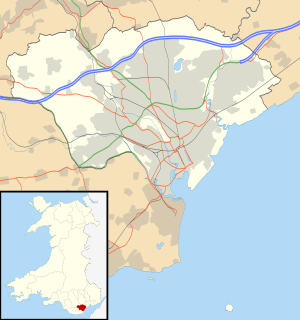
Cardiff shown within Wales
|
|||
| Sovereign state | United Kingdom | ||
| Country | Wales | ||
| Preserved county | South Glamorgan | ||
| City status | 1905 | ||
| Capital city | 1955 | ||
| Administrative HQ | City Hall | ||
| Government | |||
| • Type | Principal council | ||
| • Body | Cardiff Council | ||
| Area | |||
| • Total | 54 sq mi (141 km2) | ||
| Area rank | 19th | ||
| Population
(2022)
|
|||
| • Total | 372,089 | ||
| • Rank | 1st | ||
| • Density | 6,840/sq mi (2,641/km2) | ||
| Ethnicity (2021) | |||
| • Ethnic groups |
List
|
||
| Religion (2021) | |||
| • Religion |
List
42.9% no religion
38.3% Christianity 9.3% Islam 1.5% Hinduism 0.4% Buddhism 0.4% Sikhism 0.2% Judaism 0.6% other 6.3% not stated |
||
| Time zone | UTC+0 (GMT) | ||
| • Summer (DST) | UTC+1 (BST) | ||
| Postcode areas |
CF
|
||
| Dialling codes | 029 | ||
| ISO 3166 code | GB-CRF | ||
| GSS code | W06000015 | ||
Cardiff (pronounced CAR-diff; Welsh: Caerdydd, pronounced kair-DEETH) is the capital and largest city of Wales. It is located in the southeast of Wales, where the River Taff meets the Bristol Channel. In 2021, Cardiff had a population of about 362,400 people.
Cardiff was a small town until the early 1800s. It grew very quickly because of coal mining in the area. The city became an important port for sending coal around the world. In 1905, it was officially named a city. Then, in 1955, it became the capital of Wales.
Today, Cardiff is the main business center in Wales. It is also home to the Senedd, which is the Welsh Parliament. The city is a popular place for tourists, with many visitors each year. It's also a big center for making TV shows and movies, like Doctor Who and Sherlock.
Cardiff Bay is a modern area with the Senedd building and the Wales Millennium Centre, which is a big arts complex. New projects are still being built in Cardiff Bay and the city center.
Contents
- Cardiff's Name: What Does It Mean?
- Cardiff's Past: A Look Back
- Cardiff's Landscape and Weather
- Cardiff's People and Languages
- Cardiff's Economy and Shopping
- Getting Around Cardiff
- Education in Cardiff
- Famous Places and Fun Things to Do
- Culture and Fun in Cardiff
- Media in Cardiff
- Famous People from Cardiff
- Sister Cities
- Images for kids
- See also
Cardiff's Name: What Does It Mean?
The Welsh name for the city, Caerdydd, comes from older Welsh words. It means "the fort of the Taff". The Taff is a river that flows through Cardiff.
The name likely refers to a fort built by the Romans a long time ago. The Welsh word Caer means fort.
The English name "Cardiff" comes from the same old Welsh name. It changed over time to sound like it does today.
Cardiff's Past: A Look Back
Early Days: From Stone Age to Romans
People have lived in the Cardiff area for a very long time. Archaeologists have found signs of settlements from around 6000 BC. That's about 1,500 years before famous places like Stonehenge were finished!
Around 75 AD, the Romans built a fort near the River Taff. This fort was part of their defenses in Britain. A small town grew up around the fort, with traders and soldiers' families. The Romans left Britain by the end of the 300s.
After the Romans left, not much is known about Cardiff for a while. Wales was divided into small kingdoms.
Norman Times and the Middle Ages
In 1081, William I, King of England, started building a castle keep. This was inside the old Roman fort walls. Cardiff Castle has been a key part of the city ever since.
A town grew around the castle. By the late 1200s, Cardiff had about 1,500 to 2,000 people. This was a normal size for a Welsh town back then. It was the only town in Wales with more than 2,000 people.
In 1404, a Welsh leader named Owain Glyndŵr burned much of Cardiff. Many buildings were made of wood and were destroyed. But the town was quickly rebuilt. Cardiff was also a busy port during the Middle Ages.
Becoming a County Town
In 1536, laws were passed that created Glamorganshire. Cardiff became the main town, called the county town. In 1542, Cardiff became a borough.
A big flood in 1607 changed the course of the River Taff. It also ruined St Mary's Parish Church.
In the 1700s, Cardiff was still quite small. In 1801, only 1,870 people lived there. It was much smaller than other Welsh towns like Merthyr and Swansea.
Building the Docks: Cardiff's Big Growth
Cardiff started to grow very fast from the 1830s. This happened when the Marquess of Bute built a large dock. This dock connected to the Taff Vale Railway.
Cardiff became the main port for exporting coal. Coal came from the South Wales Valleys. The city's population grew by almost 80% every ten years between 1840 and 1870. Many people moved to Cardiff from other parts of Wales and from Ireland.
By 1881, Cardiff was the largest town in Wales. It was chosen for the University College of South Wales and Monmouthshire in 1883.
At its busiest, Cardiff's port, known as Tiger Bay, was one of the busiest in the world. It was the most important coal port for a time. Before World War I, over 10 million tonnes of coal were sent out from Cardiff Docks each year.
City and Capital Status

King Edward VII made Cardiff a city on 28 October 1905. More national buildings came to the city, like the National Museum of Wales.
Cardiff was officially named the capital city of Wales on 20 December 1955. This was a big moment for the city.
In 1958, Cardiff hosted the Commonwealth Games. The city became a center for Welsh government when the Welsh Office was set up in 1964.
In the 1980s, Cardiff's population went down. But it grew again in the 1990s. The Cardiff Bay Development Corporation worked to improve the south of Cardiff. This project made the area much better.
Cardiff's Landscape and Weather
City Location and Features
The center of Cardiff is mostly flat. It has hills to the east, north, and west. This flat land helped it become a big coal port. It was easy to get coal from the nearby valleys to the sea.
Cardiff is built on land that was once marshland. This land was drained and built upon. The River Taff flows through the city center. It joins the River Ely and flows into Cardiff Bay. Another river, the Rhymney, flows through the east of the city.
Cardiff is next to the Glamorgan Heritage Coast. This coast has yellow-blue cliffs and was once a dangerous place for ships.
City Areas and Neighborhoods
"Inner Cardiff" includes areas like Plasnewydd, Gabalfa, and Splott. Some of these areas, like those south of the A4161 road, are among the less wealthy parts of Wales. Other areas, like Gabalfa and Cathays, have many students.
To the west are Ely and Caerau, which have some of the largest housing areas in the UK. Areas like Lisvane, Cyncoed, and Radyr in the north have some of the most expensive homes in Wales.
Newer suburbs like Pontprennau are being built. There are also rural villages within Cardiff's county, like St Fagans. St Fagans is home to the Museum of Welsh Life.
Since 2000, many new tall buildings have been built in Cardiff. These are in the city center and Cardiff Bay.
Cardiff's Climate
| Weather chart for Cardiff | |||||||||||||||||||||||||||||||||||||||||||||||
|---|---|---|---|---|---|---|---|---|---|---|---|---|---|---|---|---|---|---|---|---|---|---|---|---|---|---|---|---|---|---|---|---|---|---|---|---|---|---|---|---|---|---|---|---|---|---|---|
| J | F | M | A | M | J | J | A | S | O | N | D | ||||||||||||||||||||||||||||||||||||
|
122
8
2
|
85
9
2
|
90
11
4
|
69
14
5
|
72
17
8
|
67
20
11
|
78
22
13
|
93
22
13
|
94
19
11
|
134
15
8
|
123
11
5
|
125
9
3
|
||||||||||||||||||||||||||||||||||||
| temperatures in °C precipitation totals in mm source: Met Office, 1981–2010 averages |
|||||||||||||||||||||||||||||||||||||||||||||||
|
Imperial conversion
|
|||||||||||||||||||||||||||||||||||||||||||||||
Cardiff has a mild climate. The weather is often cloudy, wet, and windy. It is one of the warmest and wettest cities in the UK.
Summers are usually warm and sunny. Winters are quite wet, but heavy rain and frost are not common. Rain can happen at any time of year, but summer showers are usually short.
Cardiff gets about 1,518 hours of sunshine each year. July is the sunniest month. It rains on about 146 days a year.
| Climate data for Cardiff (Bute Park) WMO ID: 99610; coordinates 51°29′17″N 3°11′19″W / 51.48818°N 3.18859°W; elevation: 9 m (30 ft); 1991–2020 normals, extremes 1913–present |
|||||||||||||
|---|---|---|---|---|---|---|---|---|---|---|---|---|---|
| Month | Jan | Feb | Mar | Apr | May | Jun | Jul | Aug | Sep | Oct | Nov | Dec | Year |
| Record high °C (°F) | 15.0 (59.0) |
18.3 (64.9) |
21.6 (70.9) |
26.9 (80.4) |
28.9 (84.0) |
32.1 (89.8) |
33.6 (92.5) |
34.5 (94.1) |
29.7 (85.5) |
27.1 (80.8) |
18.7 (65.7) |
16.7 (62.1) |
34.5 (94.1) |
| Mean daily maximum °C (°F) | 8.6 (47.5) |
9.2 (48.6) |
11.3 (52.3) |
14.4 (57.9) |
17.4 (63.3) |
20.1 (68.2) |
21.8 (71.2) |
21.4 (70.5) |
19.1 (66.4) |
15.3 (59.5) |
11.6 (52.9) |
9.1 (48.4) |
15.0 (59.0) |
| Daily mean °C (°F) | 5.6 (42.1) |
5.9 (42.6) |
7.6 (45.7) |
10.1 (50.2) |
13.0 (55.4) |
15.7 (60.3) |
17.5 (63.5) |
17.2 (63.0) |
14.9 (58.8) |
11.7 (53.1) |
8.3 (46.9) |
6.0 (42.8) |
11.1 (52.0) |
| Mean daily minimum °C (°F) | 2.5 (36.5) |
2.5 (36.5) |
3.9 (39.0) |
5.7 (42.3) |
8.5 (47.3) |
11.1 (52.0) |
13.1 (55.6) |
12.9 (55.2) |
10.7 (51.3) |
8.0 (46.4) |
4.9 (40.8) |
2.8 (37.0) |
7.3 (45.1) |
| Record low °C (°F) | −16.7 (1.9) |
−11.1 (12.0) |
−8.9 (16.0) |
−4.8 (23.4) |
−2.0 (28.4) |
1.0 (33.8) |
4.5 (40.1) |
3.6 (38.5) |
0.5 (32.9) |
−3.4 (25.9) |
−8.7 (16.3) |
−10.1 (13.8) |
−16.7 (1.9) |
| Average precipitation mm (inches) | 127.0 (5.00) |
93.0 (3.66) |
85.3 (3.36) |
72.1 (2.84) |
78.5 (3.09) |
73.5 (2.89) |
83.6 (3.29) |
104.8 (4.13) |
86.3 (3.40) |
129.1 (5.08) |
130.7 (5.15) |
139.6 (5.50) |
1,203.5 (47.39) |
| Average precipitation days (≥ 1.0 mm) | 15.6 | 12.0 | 12.3 | 10.7 | 11.2 | 10.4 | 11.2 | 12.4 | 11.8 | 15.0 | 15.6 | 15.2 | 153.4 |
| Mean monthly sunshine hours | 53.5 | 76.2 | 116.6 | 177.0 | 198.4 | 195.2 | 199.6 | 185.3 | 151.9 | 103.9 | 65.0 | 50.4 | 1,572.9 |
| Source 1: Met Office Ordnance Survey | |||||||||||||
| Source 2: KNMI Starlings Roost Weather | |||||||||||||
Cardiff's People and Languages
Population Growth and Diversity
Cardiff's population is growing again after a dip in the 1970s and 1980s. In 2021, about 362,400 people lived there.
Cardiff has a very diverse population. This is because of its history as a trading port. Many people from different countries came to live and work here. Today, many foreign students also attend universities in the city.
Languages Spoken in Cardiff
Cardiff has a rich language history. Both Welsh and English have been important at different times. Welsh was the main language until the city grew very fast in the Victorian era.
Today, Welsh is growing again. Many people are learning Welsh in schools. The number of Welsh speakers doubled between 1991 and 2011.
Besides English and Welsh, many other languages are spoken in Cardiff. A study found that people speak at least 94 languages here! The most common foreign languages are Somali, Urdu, Bengali, and Arabic.
Learning English in Cardiff
Because Cardiff is so diverse and has many students, people come here to learn English. Students from other countries are often seen around the city. There are several schools where you can learn English.
Religions in Cardiff
Religion in Cardiff (2021) No religion (42.9%) Christianity (38.3%) Islam (9.3%) Hinduism (1.5%) Buddhism (0.4%) Sikhism (0.4%) Judaism (0.2%) Other religion (0.6%) Not stated (6.3%)
Cardiff is home to many different religions. Llandaff Cathedral is an Anglican church and the main church for the Church in Wales. There is also a Roman Catholic cathedral in the city.
Cardiff has a long history with its Muslim community. It is one of the oldest in the UK. It started with sailors from Yemen and Somalia settling here in the 1800s. Today, there are over 11,000 Muslims in Cardiff.
The city also has Hindu, Sikh, and Jewish communities. The first Hindu temple opened in 1979. There are now three Hindu temples in Cardiff.
Cardiff's Economy and Shopping
How Cardiff Makes Money
Cardiff is the main engine for Wales' economy. Even though only about 10% of Wales' population lives here, Cardiff's economy makes up almost 20% of Wales' total income.
For centuries, industry has been key to Cardiff's growth. The city became huge because of the demand for coal. Coal was brought from the valleys to Cardiff's port to be shipped around the world.
At its busiest, Cardiff's port was one of the most important coal ports in the world. In 1907, the Coal Exchange in Cardiff was where the first business deal worth a million pounds was made.
Today, Cardiff is a major center for finance and business services in Wales. Many big companies have their main offices or call centers here. These include insurance companies and banks.
Cardiff is also one of the most popular places for tourists in the UK. In 2010, 18.3 million people visited the city. This brings a lot of money to the city. Many people in Cardiff work in hotels, restaurants, and shops.
Cardiff is also a big hub for media. BBC Cymru Wales, S4C, and ITV Wales all have studios here. Many TV shows and films are made in Cardiff. For example, Casualty, Doctor Who, and Sherlock are filmed here.
The city has many new projects. These include the St David's 2 Centre and the Cardiff International Sports Village. The Sports Village has an Olympic-standard swimming pool.
Shopping in Cardiff
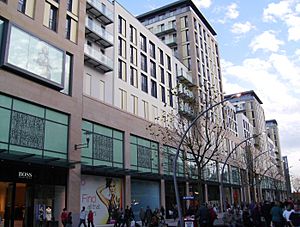
Most of Cardiff's shops are in the city center. You can find them around Queen Street and St Mary Street. There are also big shopping areas outside the city center.
The St. David's Centre was rebuilt in 2009. It is now one of the largest shopping centers in the UK. It was even named the best international shopping center in 2010.
The Castle Quarter has many Victorian and Edwardian shopping arcades. These are covered walkways with shops. Spillers Records in Morgan Arcade is the oldest record shop in the world!
Cardiff also has several markets. The Cardiff Central Market is a huge Victorian indoor market.
Getting Around Cardiff
Train Travel
Cardiff Central railway station is the biggest train station in Wales. Over 12.5 million passengers use it each year. You can get direct trains to many cities in the UK from here.
Cardiff Queen Street railway station is the second busiest. It's a hub for trains that connect the South Wales Valleys and Cardiff's suburbs to the city center.
Cardiff Metro
The South Wales Metro is a new public transport system being built. It will include electric trains and new light rail lines. This will make it easier to travel around Cardiff and nearby areas.
Air Travel
Cardiff Airport (CWL) is the only international airport in Wales. It's about 10 miles (16 km) west of the city. You can get buses and trains from the airport to Cardiff city center.
Roads and Buses
The M4 motorway connects Cardiff to other major cities like Swansea and London. The A470 links Cardiff to the valleys.
Cardiff has a big bus network. Cardiff Bus is the main company for routes within the city. You can also get long-distance buses to other UK cities.
Cycling in Cardiff
The Taff Trail is a path for walking and cycling. It runs for about 55 miles (88 km) from Cardiff Bay to Brecon. You can cycle almost the whole way off-road.
Water Travel
The Aquabus water taxi runs every hour between the city center and Cardiff Bay. You can also take boats from Cardiff Bay to Flat Holm Island.
Education in Cardiff
Cardiff has four major universities:
- Cardiff University
- Cardiff Metropolitan University
- University of South Wales
- Royal Welsh College of Music & Drama
About 43,900 students attend these universities. The city also has two colleges for further education.
Cardiff has many schools. There are nursery schools, primary schools, and secondary schools. Some schools teach in Welsh. There are also several private schools.
Whitchurch High School is the largest secondary school in Wales. Fitzalan High School is known for being very multicultural.
Famous Places and Fun Things to Do
Cardiff has many famous buildings and attractions. These include the Principality Stadium, the Pierhead Building, the National Museum of Wales, and the Senedd building.
Cardiff Castle is a very popular place to visit. It's right in the middle of the city. The National History Museum at St Fagans is a huge outdoor museum. It has dozens of old Welsh buildings that have been moved there.
The Civic Centre in Cathays Park has beautiful Edwardian buildings. These include City Hall and the National Museum.
Castell Coch is another castle in the north of the city. It looks like a fairytale castle. It was built in the 1870s but stands on the remains of a much older medieval castle.
Cardiff is said to have the most castles of any city in the world! Besides Cardiff Castle and Castell Coch, there are remains of other old castles.
(also known as Llandaff Castle)
Other popular places are the new areas in Cardiff Bay. These include the Wales Millennium Centre and the Cardiff Bay Barrage. The New Theatre is a great place to see plays and dance shows.
Cardiff has over 1,000 listed buildings. These are important historical buildings. The city also has many walking paths. The Centenary Walk goes through many of Cardiff's famous landmarks.
Culture and Fun in Cardiff
Cardiff is a lively city with lots of culture and fun things to do. It was even a finalist for the European Capital of Culture in 2008. Many people love visiting Cardiff.
Annual events include Sparks in the Park, The Great British Cheese Festival, and Pride Cymru. Cardiff Winter Wonderland and Cardiff Festival are also popular.
Music and Shows
Many concerts happen in Cardiff. Big shows are held at St David's Hall, Cardiff International Arena, and the Principality Stadium.
The Cardiff Big Weekend Festival is held every summer. It has free music, rides, and cultural events. It's one of the UK's largest free outdoor festivals.
Cardiff has hosted the National Eisteddfod many times. This is a big Welsh festival of poetry, music, and dance. The city also hosts the BBC Cardiff Singer of the World competition. This is a famous opera event.
The Wales Millennium Centre hosts opera, ballet, dance, and musicals. St David's Hall has classical music and ballet. The New Theatre is the biggest theater in Cardiff.
Cardiff has a strong music scene. It is home to the BBC National Orchestra of Wales and the Welsh National Opera. Many famous musicians come from Cardiff, like Charlotte Church and Shirley Bassey.
Sports in Cardiff
Cardiff is a big city for sports. It hosts many national and international events. In 2009 and 2014, it was named the European City of Sport.
The Principality Stadium is the national stadium for rugby union. It's home to the Wales national rugby union team. It also hosted the FA Cup final for six years while Wembley Stadium was being rebuilt.
Cardiff City F.C. is the city's main football team. They play at the Cardiff City Stadium. Cardiff City is the only non-English team to have won the FA Cup, back in 1927. They have also played in the English Premier League.
Glamorgan County Cricket Club plays at the SWALEC Stadium. This stadium hosted the first Ashes cricket test match between England and Australia in Wales in 2009.
Cardiff is also known for boxing. Many big fights have been held here. The Cardiff Devils are the city's professional ice hockey team. They play at the Ice Arena Wales.
Cardiff hosted the Commonwealth Games in 1958. The Cardiff International Pool is an Olympic-standard swimming pool. It's part of the Cardiff International Sports Village.
The Principality Cardiff Half Marathon is a big running race. It happens every October and attracts over 20,000 runners.
Parks and Green Spaces
Cardiff has many parks and green spaces. About 10% of the city's area is green!
Bute Park is the main park. It stretches north from the city center. It connects with other parks like Llandaff Fields. Together, they form a huge open space along the River Taff.
Other popular parks include Roath Park, which has a boating lake. Victoria Park, Cardiff was the city's first official park.
Media in Cardiff
Cardiff is the main base for national broadcasters in Wales. These include BBC Cymru Wales, ITV Wales, and S4C. Many TV shows and films are made here.
The main local newspaper is the South Wales Echo. The national paper is the Western Mail. Both are based in Cardiff.
There are also several magazines and a Welsh-language community newsletter. Many radio stations serve the city from Cardiff.
Famous People from Cardiff
Many famous people come from Cardiff. These include:
- Roald Dahl, a famous writer.
- Ken Follett, another well-known writer.
- Griff Rhys Jones, a comedian and actor.
- Charlotte Church, a singer.
- Shirley Bassey, a legendary singer.
- Shakin' Stevens, a popular singer from the 1980s.
- Sports stars like Tanni Grey-Thompson (Paralympic athlete) and Colin Jackson (sprinter).
- Footballers like Gareth Bale and Ryan Giggs.
- Actors like Ioan Gruffudd and Iwan Rheon.
Saint Teilo is the patron saint of Cardiff. He was a Christian monk and bishop who lived around 500 AD.
Sister Cities
Cardiff has "sister city" relationships with several cities around the world. This means they share cultural and educational links.
- Luhansk, Ukraine
- Hordaland county, Norway
- Sucre, Bolivia
- Nantes, France
- Stuttgart, Germany
- Xiamen, China
- Lima, Peru
Images for kids
-
Front wall of Cardiff Castle
part of the original Roman fort beneath the red stones -
The 26-storey Bridge Street Exchange at 85 m (279 ft) in height, is the tallest building in Cardiff.
-
St John the Baptist Church is the oldest Church in Wales building in the city
-
A stage of Wales Rally GB, hosted inside the Principality Stadium
 |
Llantrisant, Rhondda | Pontypridd, Brecon, Merthyr Tydfil, Caerphilly | Newport, Chepstow |  |
| Maesteg, Neath, Bridgend | Bristol Channel | |||
| Llantwit Major, Cardiff International Airport | Penarth, Dinas Powys, Barry | Bristol Channel |
See also
 In Spanish: Cardiff para niños
In Spanish: Cardiff para niños


